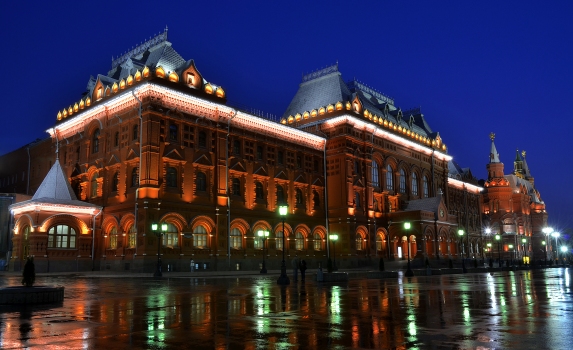General Information
Project Type
| Function / usage: |
original use: City or town hall later use: Museum building |
|---|
Location
| Location: |
Moscow, Central Federal District, Russia |
|---|---|
| Coordinates: | 55° 45' 22.35" N 37° 37' 6.68" E |
Technical Information
There currently is no technical data available.
Excerpt from Wikipedia
The former Moscow City Hall is an ornate red-brick edifice situated immediately to the east of the State Historical Museum and notable in the history of architecture as a unique hybrid of the Russian Revival and Neo-Renaissance styles. During Soviet times it served as the V. I. Lenin Museum.
History
In contrast to other European capitals, Moscow had no city hall until the establishment of zemstvo in the late 19th century. In the 1880s, when Red Square and the neighbourhood were being overhauled in the Neo-Russian style, the Moscow City Duma decided to commission an impressive building for its headquarters. During the competition that followed in 1887, architect Dmitry Chichagov (1835–94) emerged as the winner.
Building work was begun three years later, with some remains of the early 18th-century Kitai-gorod Mint incorporated into the new structure. After the Russian Revolution of 1917, the duma was disbanded and the large building was handed over to the Lenin Museum. As a consequence of this decision, opulent pre-revolutionary halls were either plastered or painted over, either to not to distract the visitor's attention from the personal effects of the deceased Communist leader exhibited there or as a negation of pre-revolutionary bourgeois culture.
Following the fall of Communism, the Moscow City Duma was reinstated but preferred to keep its headquarters in a modest building of the former Moscow Soviet on Petrovka Street. The pre-revolutionary city hall is currently employed to exhibit the vast collections of the State Historical Museum.
Architecture
Although frequently hailed as a central piece of the Muscovite Revival, Chichagov's design is in reality a hybrid of two styles favoured by the Muscovite bourgeoisie of the 1880s — Russian Revival and Neo-Renaissance.
In keeping with their tastes, the building retains the forms of Muscovite antiquity required to prepare a passerby for the medieval solemnity of the Kremlin and Red Square. The roof is reminiscent of the Terem Palace, an early 17th-century structure which may be found in the nearby Kremlin, whereas the exuberant form of ornamentation used in abundance for the façade suggests certain motifs from the adjacent State Historical Museum and the Iberian Gate.
Despite all these references to the Russian Middle Ages, the principal hall and other interiors used to be liberally seasoned with Italianate elements. The strictly symmetrical ground plan of Chichagov's building is also typical of Western architecture, as is the ornamental monotony of the façade, which fronts the Hotel Moskva, sprawling on the opposite side of Revolution Square.
Text imported from Wikipedia article "Moscow City Hall" and modified on July 23, 2019 according to the CC-BY-SA 4.0 International license.
Participants
- Dmitry Chichagov (architect)
Relevant Web Sites
- About this
data sheet - Structure-ID
20023760 - Published on:
16/10/2006 - Last updated on:
28/04/2016





